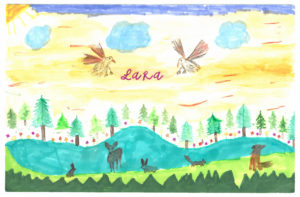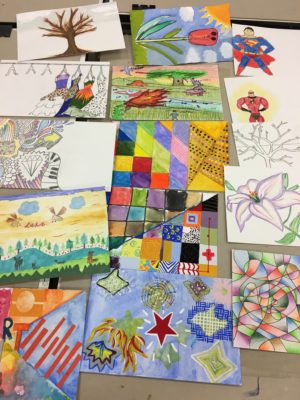By Meredith Wagner | Arts & Life Editor
Spending day after day in a hospital bed, basking in rays of sunshine filtered through a window, young children are wondering what they have yet to find, to discover, to create; pediatric cancer patients at the MD Anderson Children’s Cancer Hospital often find themselves unable to participate in the luxuries of travel or normalcies of formal education, which leaves many children void of the freedom to express themselves through arts and crafts. Students in Baylor’s art department are collaborating with patients at the MD Anderson Children’s Cancer Hospital to encourage normalization, restoration and expression among those battling cancer — young patients who arrive from all over the world and hope for a better future from behind hospital doors.
Still in its early stages, the MD Anderson program is being referred to as the “Postal Art Exchange.” Children in the Children’s Cancer Hospital are given eight-by-four inch postcards — white and blank as snow — upon which they are instructed to draw a picture of whatever they please. Their task includes one stipulation: They can’t finish their drawing. The children’s unfinished work is mailed to a professional artist elsewhere, completed and returned to the children for display or keepsake. Recently, Baylor art students have begun to participate in the program, helping children bring their Jurassic Park dreams and fashion-designer visions to fruition.
Ashley Smith, Houston native and Baylor alumnae, is heading the project with her colleague Zach Gresham at MD Anderson. Smith said the program intends to provide opportunities for the young cancer patients to connect with those who make a living off of their creativity and to dream of creative futures of their own.
“Lot of patients and families are deprived of the luxury to go travel,” Smith said. “They’re stuck in the hospital or having to do treatment. We wanted to give them the opportunity to exchange those experiences through artwork.”
Smith is program coordinator at The University of Texas MD Anderson Children’s Cancer Hospital, a position she obtained a few years after graduating from Baylor in 2015. Smith’s job entails arts programming for the hospital, which includes therapeutic-in-nature, creative art programs, in addition to educational arts programming in the hospital’s on-site school program. Smith and Gresham, who is the Arts and Medicine manager at the hospital, are tackling the collaborative project together, connecting young cancer patients to professional creatives in the community.
Smith said the artist outreach is not limited to the Waco area, but rather spans across the country and involves artists from all over the world.
“Our artist outreach actually extends everywhere from Canada to Colorado, Dallas to Mexico,” Smith said. “One of the beautiful things about it is that, on the back of the card, [the children] write where [they’re] from.”

MD Anderson’s hospitals are a hodgepodge of cultures and languages; their medical services attract patients in need from all over the world. Smith said some of the children only speak their native languages, adding that the postcards have served as the perfect mediator between patients and artists that may not be able to communicate otherwise.
“When it comes to play and art and music, there really is no language barrier,” Smith said. “People are able to communicate exactly what they’re feeling — what they’re thinking — through creative expression. There’s something really beautiful about it.”
Smith said this has allowed the program to already find success in connecting those that come from different backgrounds.
“That’s really how we’re reaching a number of different audiences and a number of different cultures, because our program is designed to break down those barriers,” she said.
Smith said the young patients were initially confused by the assignment, but that confusion quickly became excitement as they dreamed of the possibilities that could return to them weeks later.
“At first, they’re a little confused, because it’s not often that a child is told, ‘Hey, somebody’s going to be working on top of your artwork,’” Smith said. However, as soon as the kids’ postcards are mailed out, Smith said the children are eager to see how the artists complete their masterpieces.
“Every time we see [the kids], they’re like, ‘When is my card coming back! When is my card coming back!’” Smith said.

The children aren’t matched to the artists at random. Smith said the program takes the interests and creative style of the patient into consideration when they assign professional artists to complete their postcards.
“We try to match-make the artist to what they’re interested in and what would really make their pieces cohesive,” Smith said.
For example, if the child’s artwork is a collage, Smith will try to assign the card to an artist who uses an assortment of media or often mixes mediums in their imagery. If the child draws a portrait or a character, the assigned artist will likely pursue portraiture or character design.
Greg Lewallen, Baylor lecturer of arts and sciences and former art instructor of Smith’s, was contacted to be one of the artists to complete a postcard.
“She contacted me initially to see if I would be one of the artists willing to participate in this program,” Lewallen said. “I got to thinking about it — Would this be something my students could do?”
Not too long after Lewallen proposed this question, the students in his 2-D Design class were filling in the unfinished cards with colored pencils, paints and markers, coloring both inside and outside of the already-sketched lines.
Lewallen recalled walking the halls of MD Anderson himself, when his daughter-in-law was undergoing treatment for cancer. She passed away at the young age of 28, and Lewallen said this experience has made the Postal Art Exchange program that much more meaningful to him.
“We’re just happy to be able to participate,” Lewallen said. “I’m hoping, at the beginning of next semester, that we can make this a regular thing.”
The hospital’s other art programs range from one-on-one projects to large-scale, collaborative pieces. In the past, one program has attached some of the children’s art work to space suits, which astronauts wear during their space travel. The astronauts later visited the children in the hospital, wearing the space suits with their artwork patched onto it.
“They get really encouraged to see their work doing something large,” Smith said. “[It’s special] to see the kids’ faces light up when they see their work in a really unique space.”
As for now, Smith said the Postal Art Exchange program is at its earliest stages, but she hopes that the program will expand and fill MD Anderson’s gallery walls.
“We’re just sort of growing bit by bit. Right now, we’re growing at a rate of about five cards completed per week. Ideally, it will grow to be hundreds and hundreds of cards,” Smith said. “We’re very hopeful that it will become a regular program for us. It’s been successful so far.”
Lewallen said he is proud to watch one of his former students succeed and apply her skills to something so meaningful.
“She could have very easily been an art major. Her problem is she’s too cotton-pickin’ smart,” Lewallen said. “I’m very proud that she’s using her talent and her skills and her creativity.”
Smith said she feels honored to still be in contact with her former professor and her alma mater.
“It really is an honor to be in contact with [Lewallen] and to have his support,” Smith said. “The department as a whole — it has been really great to have that kind of enthusiasm even though I’m not a student anymore.”




